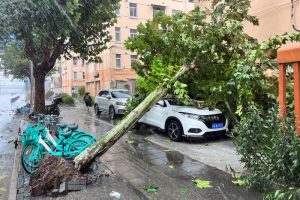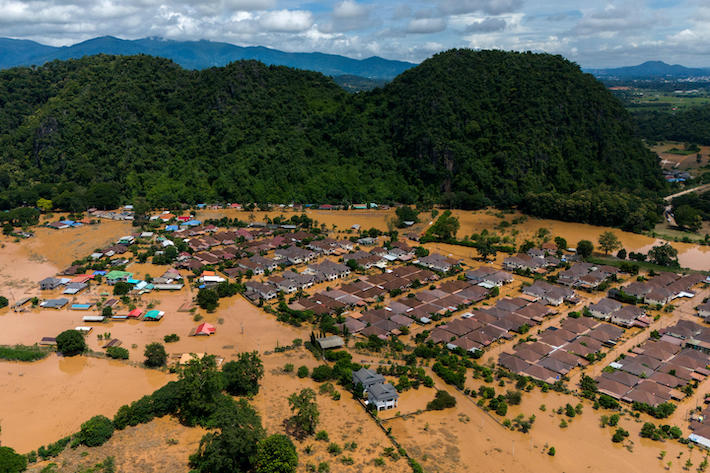Another huge storm – the biggest to hit Shanghai in over 70 years – brought China’s commercial capital to a standstill on Monday.
It takes a pandemic or major danger to empty the streets in a thriving financial hub that is home to 25 million people, but Bebinca was the second cyclone in a week to hammer China.
More than 1,400 flights at the mega-city’s two airports and nearby cities were suspended, cancelled or re-routed from 8pm on Sunday and 400,000 evacuated from areas deemed at risk from the latest extreme weather event.
ALSO SEE: Big US Banks Cut China Growth Outlook Amid Industrial Slowdown
The good news is its officials appear to be well-rehearsed on what to do, and that probably saved many lives and limited the damage, unlike its neighbours in Southeast Asia – Vietnam, northern Thailand and Myanmar – who suffered appalling losses and widespread damage when Typhoon Yagi swept through last week.
The bad news is intense tropical storms are becoming part of the new ‘normal’ in China, where the leadership insists they cannot ditch coal-fired electricity – because, as in India, many citizens still lack power. And that is, of course, now widely seen as causing these extreme weather events.
So, while this was the biggest storm to strike Shanghai since Typhoon Gloria in 1949, a vast number of ships, planes, trains and vehicles were out of harm’s way when the category 1 storm – with winds of up to 151 kph (94 mph) – blazed through around 7.30am.

Rain lashed the city and strong winds felled more than 10,000 trees and many billboards across Shanghai. But casualties were limited, as tens of millions were bunkered down at home or shifted to safe havens.
More than 56,000 rescue workers were deployed and, by early afternoon only one injury had been reported as a result of the storm, according to state media reports.
More than 570 passenger trains were cancelled since Sunday evening, disrupting the travel plans of many people on the move over the Mid-Autumn Festival holiday, a three-day public holiday in China.
Parks and businesses were closed as four districts in Shanghai upgraded weather alerts to the highest possible level, some metro train services were disrupted and highways and elevated roads were also closed to traffic or had special speed restrictions in place.
Resorts in Shanghai, such as the Disney Resort, Jinjiang Amusement Park and Wild Animal Park, were also temporarily closed and many ferries halted.
By Monday afternoon, the eye of the storm had crossed to neighbouring Jiangsu province, though rains were expected to continue in China’s financial capital throughout the rest of the day.
Shanghai is rarely subject to direct hits from strong typhoons, which generally make landfall further south in China.
Trail of damage through Vietnam, Thailand, Myanmar
Meanwhile, Vietnam, Thailand and Myanmar, are still battling to recover from a trail of destruction caused by Typhoon Yagi, a destructive Category 4 storm that roared through Hainan Island, northern Vietnam, Laos, Thailand and even parts of Myanmar in recent days.
The death toll in Vietnam looks set to pass 350, with 273 fatalities confirmed, 78 people missing and nearly 2,000 injured, according to the latest UN update.
It said authorities have mounted a massive recovery effort after prolonged rains over five days raised river levels and triggered flooding and landslides.
An international appeal has been launched to help the more than 74,500 families that were displaced, while over 183,000 hectares of crops were flooded, 168,000 homes damaged and two thirds of them evacuated.
People in northern Thailand have also suffered, with flooding in Chiang Rai affecting more than 9,000 families, some of whom are stranded in their homes awaiting help from rescue teams.
People are also injured and missing in Chiang Mai, while many areas in Nan in the far northeast are enduring the worst flood in 100 years, according to the Bangkok Post.
The death toll in Myanmar, which is enduring its worst military strife since perhaps the Second World War – also appears to be severe.
At least 60 people have died and more than 100 are missing in floods and mudslides in Yamethin township in Mandalay region, according to Irrawaddy, plus there have been reports of serious fatalities in other parts of the southeast.
“Casualties were mainly reported in eight hillside villages around the Moe Hti Moe Mi gold mine in eastern Yamethin, where houses were swept away by the torrents or buried in mudslides,” it said.
Meanwhile, 18 medics who were killed by flooding in Demoso township in Karenni (Kayah) State, according to an anti-resistance group. The medics were attending training course run a the Karenni Nationalities Defence Force – swept away during a river crossing exercise, the KNDF said on Friday.
- Jim Pollard with Reuters.
ALSO SEE:
China’s Billion-Ton Coal Expansion Plan Sparks Methane Fears
UK First G7 Nation To End Coal-Fired Power Generation – FT
China Slows Coal Power Plant Building Push – Yahoo
China Coal Output Rises But Power Generation Use Declines
China Turns to Carbon Capture, Biomass For Coal Power Emissions
























